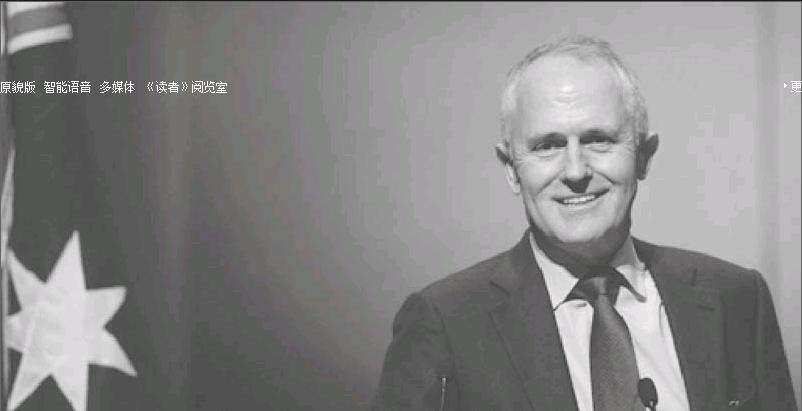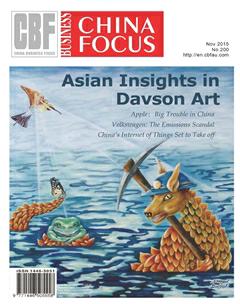Australia Ready to Ratify China Trade Deal

Australia is poised to ratify a trade deal with China after the opposition Labor party proposed a compromise to address fears that projects enabled by the treaty would favor Chinese workers.
The breakthrough comes as Malcolm Turnbull, the prime minister, seeks to build a national consensus on reforms to stimulate growth even as the economy of China, Australias biggest trading partner, slows.
The trade deal, which was signed in June but requires legislation, would cut tariffs and remove other impediments to Australian exports while relaxing rules on Chinese inward investment. It underpins a deepening relationship between Canberra and Beijing in which Australia this year joined the Asian Infrastructure Investment Bank against the wishes of the US, its key ally.
Labors compromise, which follows a campaign by unions against the treaty, would mean amending domestic laws rather than the trade deal. The party wants employers seeking workers for projects enabled under the deal to be required to advertise locally before recruiting abroad. It also wants workers in trades such as electrics or plumbing to obtain an Australian occupational license or registration within 60 days of arrival.
The looming removal of barriers to trade with China comes as Australias resource-rich economy faces its greatest challenge since the global financial crisis. Sharp falls in the value of its main exports and concerns about the health of the Chinese economy have dented business confidence and caused economic growth to slow to about 2 per cent, below a long-term trend above 3 per cent.
Finance Minister Mathias Cormann,however, believes investor concerns about the Chinese economy were overblown.
“We have probably a more positive outlook on China than other parts of the world that are a bit more removed,” he said. “It is making a significant shift from investment-driven growth to domestic consumption-driven growth and there will be some challenges along the way as you work on a transition of this scale. But from where we sit we are optimistic about the outlook.”
China has been roiling global markets all summer as its authoritarian leaders try to stop a huge stock bubble from bursting and its slowing economy from stalling.
Mr Cormanns assessment contrasts with that of Graeme Wheeler, New Zealands central bank governor, who said on Wednesday his “greatest concern” was Chinas growth outlook. New Zealand also counts China as its biggest trading partner.

Chinese appetite for iron ore and coal drove a decade-long explosion in mining investment in Australia and boosted bilateral trade to A$160bn in 2013-14. But as Chinas construction boom fades, Canberra is eager to export more agricultural products and services to keep its economy growing.
Mr. Cormann said the trade deal would open up opportunities to healthcare, education, financial services and food companies to sell to Chinas growing middle class.
Australias Jobless Rate Steady at 6.2%
Australias unemployment rate remained stable at 6.2% in September, according to latest data from the Australian Bureau of Statistics.
Some analysts suggest it may have peaked as the economy moves away from a dependence on mining.
Data showed that in rounded terms, some 5,100 jobs were lost from the economy, with full-time positions falling by about 13,900 and part-time roles increasing by around 8,900.
The seasonally adjusted reading was better than analysts expectations of an increase to 6.3%, although the market was disappointed with the decline in the number of jobs.
In unrounded percentage terms, the data were more positive, with unemployment dipping slightly from 6.22% in August to 6.16% in September.
The participation rate, which measures the proportion of adults in work or looking for work, eased from 65% to 64.9%.
The unemployment rate has fluctuated between 6% and 6.4%, a decade high, over the past year as Australia emerges from an unprecedented mining investment boom that has helped the economy avoid a recession for 24 years.
The central bank has slashed interest rates to a record low of 2% to boost economic activity outside the resources sector, but such industries have so far been slow to fill the gap left by the fall in mining investment.
However, the unemployment rate has yet to hit the 6.5% peak that the Reserve Bank of Australia forecast amid the transition to non-resources driven growth.
The figures came as new consumer and business confidence indicators recorded modest rises after multi-millionaire former banker and businessman Malcolm Turnbull became prime minister when he ousted Tony Abbott in a party coup last month.
Turnbull has vowed to speak honestly about the economy and the headwinds facing it amid a slump in commodity prices and slowing growth in China, Australias largest trading partner.
Economist Justin Fabo of ANZ, which is forecasting the central bank to cut rates by 50 basis points in early 2016, said he expected the rate of jobs growth to slow on continued softness in the domestic and global economies.
Australias Labor Party Leader Promises 30,000 Jobs
Bill Shorten, Leader of the Australian Labor Party, recently promised thousands of extra jobs from a AUS$10 billion reorganization of how government invests in infrastructure.
He said some 30,000 would be created directly from an overhaul of funding of major projects, with just three individual projects boosting employment by 10,000.
Mr. Shorten believed improvements to productivity from the capital works would create thousands more in the general economy.
A Labor government would turn the existing advisory body Infrastructure Australia into an independent funding source for big private/public capital works developments, as investor or guarantor.
“Just as the Reserve Bank of Australia is the independent authority at the centre of monetary policy, Infrastructure Australia will be at the centre of capital investment, driving results that are in the national interest,” Mr. Shorten said.
He revealed in a speech the newlydefined body would be an “active participant in the infrastructure market, mobilizing private sector finance”.
It would have AUS$10 billion to deploy and other funds could be expected from Australias superannuation industry, which could have AUS$4 trillion in deposits by 2025, and international inves-tors.
Mr. Shorten argued the objective is to fill big gaps in the demand for infrastructure, and to create jobs.
Labor said it has used a conservative analysis prepared by Infrastructure Partners Australia, which showed a AUS$10 billion investment would directly create approximately 26,000 jobs and add AUS$7.5 billion a year to economic growth.
“Building these projects is Labors priority, because building infrastructure creates jobs,” said Mr Shorten.
Infrastructure Australia has estimated that the economic cost of under investment is projected to reach $53 billion a year by 2031.
Australia, EU Poised to Kick off Free Trade Talks
Australia is preparing for another major trade deal after the European Union said it will begin work on a free trade agreement in the coming months.
As part of a new trade and investment strategy announced on Wednesday, the European Commission said it would seek authorization from its 28 members to open separate negotiations with “close partners” Australia and New Zealand.
Any deal with the EU would have big implications for Australian farmers which have long been pushing for lower tariffs and greater access to a European market of some 500 million customers.
However, the EU announcement said any deal would need to take into account “agricultural sensitivities” with European farmers likely to oppose any substantial relaxation of protectionist measures for sheep, beef and dairy imports.
Agriculture in the EU is heavily subsidized, with payments under the Common Agriculture Policy accounting for 40 per cent of the organizations budget.
According to the European Commission, Australia ranked as the EUs 21 largest trade while the EU represented Australias third largest trading partner after China and Japan in 2014. Total trade in goods amounted to €38.7 billion in 2014.
Australias exports to the EU have traditionally been dominated by mineral commodities and energy as well as agricultural products while EUs exports to Australia are predominantly manufactured goods such as cars.
The European Commission said the new trade and investment policy was a direct response to the “current intense debate on trade in the EU - including on the Transatlantic Trade and Investment Partnership”.
Australia this month signed the Trans Pacific Partnership agreement, which will create a free-trade area covering 40 per cent of the global economy aimed at addressing “21st century trade issues” such as intellectual property protections, digital trade rights and protections for investors. The TPP followed another high-profile free trade deal struck with China in June.
Trade Minister Andrew Robb said a deal with the EU was a “missing piece”after the conclusion of the other agreements.
A number of steps must be completed for formal negotiations to begin. First, the EU will conduct an impact assessment of the FTA. Second, it will commission a study to examine areas of negotiation. The European Councils 28 members must also give their permission to open negotiations but EU officials are confident previous consultation mean this stage is a formality.
One of the goals of the EU trade policy is to “expanding measures to support sustainable development, fair and ethical trade and human rights”.
The potential focus on human rights clauses has been a source of tension in the past. Former EU ambassador Brendon Nelson has previously argued Australia should never sign a free trade agreement with the EU if talks included demands for tough clauses on human rights, democracy and the rule of law.

